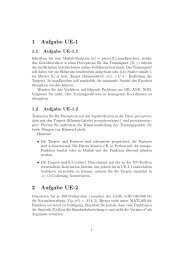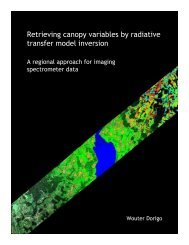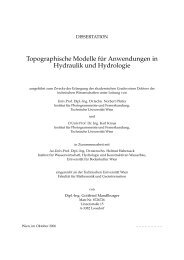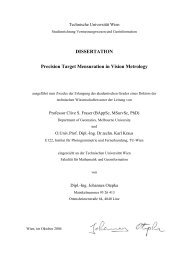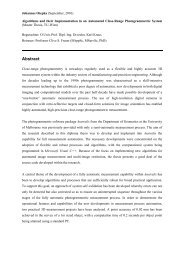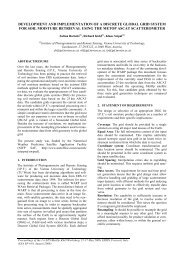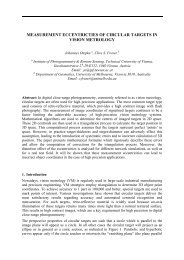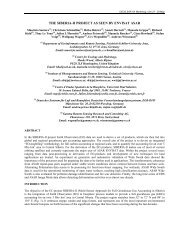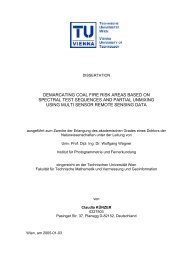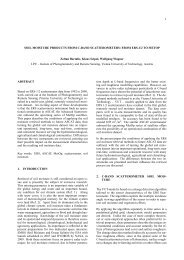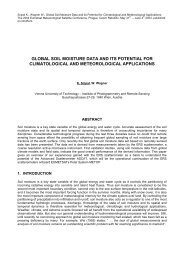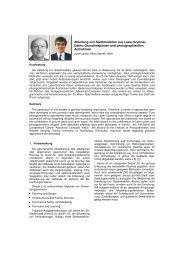Processing of laser scanning data for wooded areas - Institute of ...
Processing of laser scanning data for wooded areas - Institute of ...
Processing of laser scanning data for wooded areas - Institute of ...
You also want an ePaper? Increase the reach of your titles
YUMPU automatically turns print PDFs into web optimized ePapers that Google loves.
Kraus, Rieger 221<br />
<strong>Processing</strong> <strong>of</strong> <strong>laser</strong> <strong>scanning</strong> <strong>data</strong> <strong>for</strong> <strong>wooded</strong> <strong>areas</strong><br />
KARL KRAUS and WOLFGANG RIEGER, Wien<br />
ABSTRACT<br />
Airborne <strong>laser</strong> scanners have been increasingly used in recent years <strong>for</strong> the collection <strong>of</strong> terrain elevation <strong>data</strong> especially<br />
in <strong>wooded</strong> <strong>areas</strong>. The technology demands new processing technologies which have reached a stage <strong>of</strong> good practical<br />
application so far <strong>for</strong> the interpolatin <strong>of</strong> ground DTMs. Beyond pure ground DTMs, however, <strong>laser</strong> scanner <strong>data</strong> have<br />
great potential <strong>for</strong> other applications such as creation <strong>of</strong> digital building models or vegetation analysis. The paper<br />
presents the state <strong>of</strong> the art <strong>of</strong> interpolation techniques along with a new technique to separate <strong>wooded</strong> from non<strong>wooded</strong><br />
<strong>areas</strong> even in the special case <strong>of</strong> <strong>of</strong>f-terrain objects (buildings, rocks) which would normally be eliminated from<br />
the ground model. Finally methods are outlined to extract in<strong>for</strong>mation on <strong>for</strong>est stands, such as mean stand height, stand<br />
density, and tree species, directly from <strong>laser</strong> scanner <strong>data</strong>.<br />
1. INTRODUCTION<br />
The collection <strong>of</strong> high precision digital terrain models (DTMs) in <strong>wooded</strong> <strong>areas</strong> was an unresolved<br />
problem till recent years. Laser <strong>scanning</strong> is the first method that allows to accomplish that task. In<br />
the meantime ample experience has been collected, <strong>for</strong> example at the regional surveying <strong>of</strong>fices in<br />
Germany (H. Hahn, M. Knabenschuh, W. Stössel, 1999). The obtainable accuracy <strong>of</strong> DTM points<br />
that were derived from <strong>laser</strong> scanner <strong>data</strong> in <strong>wooded</strong> <strong>areas</strong> can be given as (K. Kraus, 2000):<br />
σ H [cm] = ± (18 + 120·tanα) (1)<br />
Equation (1) is valid <strong>for</strong> a ground penetration rate <strong>of</strong> the <strong>laser</strong> signal <strong>of</strong> at least 25 % and a good<br />
mixture <strong>of</strong> vegetation and ground points <strong>for</strong> the whole region. The relatively high dependence <strong>of</strong> the<br />
elevation accuracy on the terrain slope tanα is due to several reasons:<br />
• In steep <strong>areas</strong> the topographic surface tends to be less well-defined than in flat <strong>areas</strong>.<br />
• The ground extent <strong>of</strong> the scanner flex – which is about 20 cm at a flying height <strong>of</strong> 1000 m – can<br />
be ignored in flat <strong>areas</strong> but has significant influence in steep terrain.<br />
• The inherent plane errors <strong>of</strong> the on-line GPS position and INS orientation strongly influence the<br />
elevations in steep terrain in contrast to flat terrain.<br />
Photogrammetric <strong>data</strong> collection methods show a similar accuracy law as <strong>laser</strong> <strong>scanning</strong> DTMs<br />
(K. Kraus, 2000). The photogrammetric accuracy depends on the flying height. The accuracy in<br />
open terrain <strong>of</strong> a DTM that was plotted from wide angle images at a flying height <strong>of</strong> 1200 m,<br />
resulting in an image scale <strong>of</strong> 1 : 8000, is comparable to that <strong>of</strong> a <strong>laser</strong> DTM in <strong>for</strong>ests.<br />
The elimination <strong>of</strong> inherent systematic errors allows a significant improvement <strong>of</strong> the accuracy <strong>of</strong><br />
the <strong>laser</strong> DTM particularly in flat terrain. The constant value <strong>of</strong> ± 18 cm in equation (1) can be<br />
reduced down to ± 10 cm (K. Kraus, N. Pfeifer, 1998).<br />
The geomorphological quality <strong>of</strong> the DTMs that were derived from <strong>laser</strong> scanner <strong>data</strong> is not yet<br />
satisfactory especially along break lines <strong>of</strong> the terrain. In the publication (K. Kraus, N. Pfeifer 1998)<br />
several suggestions were made to improve the geomorphological quality. Currently the following<br />
method is the most effective one: The <strong>laser</strong> DTM is overlaid over photogrammetric imagery (with<br />
s<strong>of</strong>tcopy plotters or by image injection on analytical stereoplotters) and edited manually. The<br />
method implies the availability <strong>of</strong> both <strong>laser</strong> scanner <strong>data</strong> and aerial images <strong>of</strong> the region <strong>of</strong> interest<br />
and at least some degree <strong>of</strong> ground visibility in the aerial photographs. The operator is usually able
222 Kraus, Rieger<br />
to detect potential breaklines in the <strong>laser</strong> DTM and may collect them and eventually improve the<br />
DTM with help <strong>of</strong> the stereoscopic imagery.<br />
2. CLASSIFICATION AND FILTERING OF THE LASER SCANNER DATA<br />
For the processing <strong>of</strong> <strong>laser</strong> scanner <strong>data</strong> a special algorithm has been developed and implemented in<br />
the DTM program package SCOP (N. Pfeifer, K. Kraus, A. Köstli, 1999). This algorithm estimates<br />
the skewness <strong>of</strong> the error distribution <strong>of</strong> the <strong>laser</strong> scanner <strong>data</strong> in <strong>for</strong>ests and assigns small weights<br />
to those points that show large positive errors during the interpolation with filtering. The process<br />
results in a classification <strong>of</strong> the <strong>laser</strong> points in terrain and <strong>of</strong>f-terrain (mainly vegetation) points.<br />
Following, interpolation is restricted to one or the other set <strong>of</strong> points.<br />
According to that method the following projects are currently processed at the <strong>Institute</strong> <strong>for</strong><br />
Photogrammetry and Remote Sensing at the TU Vienna (I.P.F.).<br />
• Riparian <strong>for</strong>ests <strong>of</strong> the Danube below Vienna on behalf <strong>of</strong> the Österreichische Wasserstraßendirektion.<br />
The region <strong>of</strong> interest has an extent <strong>of</strong> approx. 40 km². The <strong>laser</strong> scanner flight was<br />
undertaken by the company "TopoSys". It is expected to reach an overall accuracy between<br />
10 and 20 cm even within the densely <strong>for</strong>ested <strong>areas</strong>.<br />
• Vienna Woods in behalf <strong>of</strong> the Magistratsabteilung 41 <strong>of</strong> the municipal authority <strong>of</strong> Vienna.<br />
The total area <strong>of</strong> about 90 km² was previously surveyed with the <strong>laser</strong> scanner <strong>of</strong> the company<br />
"TopScan" (K. Kraus, E. Hynst, P. Belada, T. Reiter, 1997). A small part <strong>of</strong> the area has been<br />
captured by a <strong>laser</strong> scanner <strong>of</strong> the company "TopoSys" in late winter 1999. The I.P.F. is going<br />
to derive a DTM from that <strong>data</strong> and compare the DTMs from the two different <strong>laser</strong> <strong>data</strong> sets.<br />
• A map sheet <strong>of</strong> the <strong>of</strong>ficial map <strong>of</strong> the Bayerisches Landesvermessungsamt. The <strong>laser</strong> scanner<br />
<strong>data</strong> <strong>of</strong> that area were already processed with morphologic filters by the company "TopScan"<br />
(C. Weber, 1999). For comparison reasons these <strong>data</strong> are currently modelled with the filtering<br />
algorithms that have been developed at the I.P.F.<br />
At the Photogrammetric Week results <strong>of</strong> the processing <strong>of</strong> these three projects are presented. The<br />
main focuses <strong>of</strong> the current contribution are,<br />
• a method that enhances the I.P.F.´s interpolation with filtering with a skew error distribution<br />
function (section 3) in order to automatically separate small solid <strong>of</strong>f-terrain objects, and<br />
• the application <strong>of</strong> <strong>laser</strong> <strong>scanning</strong> to estimate <strong>for</strong>est stand parameters (section 4).<br />
3. ENHANCEMENT OF THE INTERPOLATION WITH FILTERING<br />
Although the implemented algorithm allows to automatically distinguish between <strong>areas</strong> that need to<br />
be processed with a skew error distribution, i. e. <strong>for</strong>ested <strong>areas</strong>, and regions with a symmetric error<br />
distribution, i. e. non-<strong>for</strong>ested <strong>areas</strong>, there are some critical constellations that may cause problems.<br />
N. Pfeifer, K. Kraus and A. Köstli (1999) processed a region in the Sächsische Schweiz near<br />
Dresden which is characterized by many rock needles positioned within the <strong>for</strong>ested <strong>areas</strong>. The size<br />
<strong>of</strong> these needles <strong>of</strong>ten nearly does not exceed the size <strong>of</strong> single trees, thus the rock points are<br />
eliminated along with the vegetation points.<br />
The area was processed at the TU Dresden and at the I.P.F. with SCOP. A contour plot <strong>of</strong> a surface<br />
created from all <strong>laser</strong> points was used to interactively delimit the rocky from the <strong>for</strong>ested <strong>areas</strong>. This<br />
is possible since the shape <strong>of</strong> the contours differs between rock needles and trees. Wooded <strong>areas</strong><br />
were processed with the skew error distribution function, rocks with the symmetric one. The figures<br />
in the publication (N. Pfeifer, K. Kraus, A. Köstli, 1999) show satisfactory results.
Kraus, Rieger 223<br />
Following, a method is proposed that automatically allows to distinguish between <strong>for</strong>ested and non<strong>for</strong>ested<br />
<strong>areas</strong>. Two <strong>laser</strong> <strong>data</strong> sets are needed, first reflected pulse and last reflected pulse. The<br />
algorithm was implemented on grid DTMs that were derived with interpolation from the two <strong>data</strong><br />
sets with 1 m grid width. Better results will certainly be obtained with the original <strong>laser</strong> <strong>data</strong>.<br />
If the terrain surface <strong>of</strong> the region is known, the <strong>laser</strong> <strong>data</strong> can be trans<strong>for</strong>med into "object<br />
elevations" by simply subtracting the terrain elevation from the <strong>laser</strong> <strong>data</strong>. This is done <strong>for</strong> both the<br />
first and the last pulse <strong>data</strong> set. Thus it is possible to distinguish between different ground<br />
coverages, since the two pulses exhibit different elevation distributions, penetration rates, and<br />
roughness parameters both from one another and between different ground coverages<br />
(see section 4). Another very important <strong>data</strong> set is the difference between first and last pulses <strong>of</strong> the<br />
same area. This difference model shows how far the <strong>laser</strong> pulse may penetrate into the object on a<br />
point-to-point base rather than <strong>for</strong> a whole area. Several problems are still present:<br />
• The terrain surface is not known accurately; rather, its derivation is the main aim <strong>of</strong> the process.<br />
Thus iteration is necessary: First, the DTM is derived according to the methods described<br />
above; from that model primary estimates <strong>of</strong> the object elevations are derived. Following, the<br />
interpolation is repeated by subsequent introduction <strong>of</strong> the iteratively refined knowledge about<br />
the ground coverage, which furthermore allows to improve the parameters.<br />
• A larger area is necessary to estimate statistical parameters such as elevation distribution or<br />
roughness. There<strong>for</strong>e segmentation is needed which is, however, not available at that stage; in<br />
contrary, it is part <strong>of</strong> the results <strong>of</strong> the process. The segmentation is based on the measures that<br />
need to be estimated from the segments, thus again iteration is mandatory. The difference<br />
between first and last pulse is <strong>of</strong> great help in that case, since rocks and buildings exhibit<br />
differences close to zero in contrast to vegetation.<br />
• The size <strong>of</strong> the objects is <strong>of</strong> crucial importance. Trees and buildings are <strong>of</strong>ten <strong>of</strong> similar size<br />
whileas terrain features tend to be larger. Un<strong>for</strong>tunately, in <strong>areas</strong> like Sächsische Schweiz rock<br />
needles may be <strong>of</strong> similar size as trees.<br />
Figure 1 shows the process <strong>of</strong> automatic separation <strong>of</strong> the <strong>wooded</strong> <strong>areas</strong> in contrast to the non<strong>for</strong>ested<br />
<strong>areas</strong>: Figures 1b and 1c show the difference <strong>data</strong> sets "summer first" minus "summer last"<br />
respectively "summer last" minus "ground model". All <strong>areas</strong> that exhibit differences larger than a<br />
threshold <strong>of</strong> 1 m in the first <strong>data</strong> set are assumed to be vegetation points, <strong>areas</strong> with values lower<br />
than 1 m in the second <strong>data</strong> set are assumed to be impenetrable <strong>for</strong> the <strong>laser</strong> scanner, i. e. buildings<br />
or rocks or similar. The threshold value is critical; it should further be tuned to the local slope in<br />
order to obtain more reliable results. Figure 1d shows the resulting <strong>of</strong>f-terrain object mask which<br />
has additionally been processed by a 3 x 3 despeckle filter.<br />
The first-last difference tends to exhibit "dams" along the edges <strong>of</strong> buildings or, more generally,<br />
along "walls" in the terrain (Figure 1c); this is due to the ground size <strong>of</strong> the <strong>laser</strong> spots (that may<br />
only partly hit ro<strong>of</strong>s along the edges) and because most <strong>laser</strong> beams are sent in oblique direction<br />
rather than vertical and may arise from different flying stripes. Discretization into a grid further<br />
deteriorates the quality. Ideally both the first and last reflected signal <strong>for</strong> each <strong>laser</strong> pulse should be<br />
reflected in order to minimize the effective <strong>of</strong> the ground spot extent; this was not the case with the<br />
TopoSys <strong>laser</strong> scanner in the Rosalia example. Rather two flights were undertaken which<br />
additionally accounts <strong>for</strong> a portion <strong>of</strong> the dams.<br />
Figure 1f shows a hill shading visualization <strong>of</strong> the ground model with the buildings extracted from<br />
the <strong>data</strong> set "summer first". All models are regular grid models with 1 m grid width.<br />
The mask (Figure 1d) can certainly still be improved, however, the process is fully automatic and<br />
can be the base <strong>for</strong> a more sophisticated break line detection task.
224 Kraus, Rieger<br />
The usage <strong>of</strong> aerial or satellite imagery may be <strong>of</strong> great help to better distinct between vegetation<br />
and non-vegetation. Another, most promising approach, is to collect in<strong>for</strong>mation about the intensity<br />
<strong>of</strong> the reflected radiance with the <strong>laser</strong> scanner, as can be done with the ScaLARS (Scanning Laser<br />
Altitude and Reflectance Sensor) that was recently introduced as a prototype (A. Wehr,<br />
C. Hug, 1999). The intensity <strong>of</strong> the reflected radiance in near infrared (810 nm) differs widely<br />
between vegetation and non-vegetation as is well-known, thus distinction is easily possible.<br />
a b c<br />
d e f<br />
Figure 1: Separation <strong>of</strong> vegetation (trees) and solid <strong>of</strong>f-terrain objects (buildings): (a) Ortho image<br />
<strong>of</strong> the area; (b) "Summer last" minus ground model, (c) "Summer first" minus "summer last";<br />
(d) mask <strong>of</strong> buildings derived from (b) and (c) where b is higher than 1 m and c is lower than 1 m, a<br />
3 x 3 despeckle filter was used afterwards; (e) extracted building points; (f) hill shading <strong>of</strong> DTM<br />
(ground model) with buildings implanted. Coding: Higher elevations are darker (b, c, e).<br />
4. APPLICATION OF LASER SCANNING IN FORESTRY<br />
The Agricultural University <strong>of</strong> Vienna operates a research <strong>for</strong>est south <strong>of</strong> Vienna. A part <strong>of</strong> that<br />
area was captured with a <strong>laser</strong> scanner by the company "TopoSys" at August 19, 1998 in two flights<br />
(recording the first respectively last reflected signals <strong>for</strong> each <strong>laser</strong> pulse, resulting in <strong>data</strong> sets<br />
"summer first" respectively "summer last") and at March 26, 1999 (leafless season) with the last<br />
signal recorded, resulting in a <strong>data</strong> set "winter last". The last flight was used to create a terrain<br />
surface model (DTM) by means <strong>of</strong> the interpolation and filtering with a skew error distribution<br />
function. Figure 2 shows contours <strong>of</strong> a part <strong>of</strong> the area (300 x 200 m²) with a contour interval <strong>of</strong><br />
2 m, interpolated from the "winter last" <strong>data</strong> set with the filtering with a skew error distribution<br />
function. During the processing a classification in terrain points and <strong>of</strong>f-terrain points was obtained.
Kraus, Rieger 225<br />
Following, the relative (against the terrain) elevations ∆h were calculated <strong>for</strong> all <strong>laser</strong> dots <strong>of</strong> the<br />
flight "summer first" by simply subtracting the corresponding (interpolated) terrain elevation from<br />
each <strong>laser</strong> point. These relative elevations ∆h were used to classify the <strong>laser</strong> dots:<br />
• All <strong>laser</strong> points with ∆h < 2 m were eliminated, i. e. all points <strong>of</strong> the flight “summer first” at the<br />
terrain surface as well as those in meadows, bushes, and re<strong>for</strong>estation <strong>areas</strong>.<br />
• All <strong>laser</strong> points with ∆h > 40 m were eliminated, because these points cannot be tree points in<br />
that region (amazingly relatively many points were eliminated by this criterion. Presumably<br />
most <strong>of</strong> these dots result from birds).<br />
Figure 2: Terrain surface obtained from "winter last" with interpolation and filtering<br />
with a skew error distribution function.<br />
The points classified as tree points in "summer first" were joined with the terrain points <strong>of</strong> "winter<br />
last". The result is shown as a contour plot in Figure 3 with a contour interval <strong>of</strong> 5 m. The <strong>for</strong>ested<br />
<strong>areas</strong> and even single trees can easily be recognized along with the different tree heights. In the<br />
perspective view the impression is further increased (Figure 5), especially in contrast to the plain<br />
ground model (Figure 4). The grid width <strong>of</strong> the "canopy model" is 5 m, thus the surface does not<br />
represent the real canopy surface or single trees within the <strong>for</strong>est stands, but rather a kind <strong>of</strong> a mean<br />
canopy surface with the effective roughness reflected quite well.
226 Kraus, Rieger<br />
Figure 3: Terrain points <strong>of</strong> "winter last" joined with canopy points <strong>of</strong> "summer first".<br />
Figure 4: Perspective view <strong>of</strong> ground model.
Kraus, Rieger 227<br />
Figure 5: Perspective view <strong>of</strong> ground model with vegetation implied.<br />
It is near at hand to interpolate a canopy surface simply from the mentioned tree points as collected<br />
with the first reflected pulse (the question <strong>of</strong> the definition <strong>of</strong> a canopy surface is not discussed<br />
here). Two methods are obvious:<br />
• Either the interpolation with the skew error distribution function is used, yet with low weights<br />
<strong>for</strong> points with large negative errors (i. e. points below the canopy).<br />
• Or all elevations are multiplied by –1, and the interpolation with the skew error distribution<br />
function is used the same way as with the derivation <strong>of</strong> the terrain surface.<br />
Figure 6 shows a "canopy surface" that was calculated by the second method. If the terrain surface<br />
<strong>of</strong> Figure 1 is subtracted from that canopy surface, a map <strong>of</strong> the elevation distribution <strong>of</strong> the trees<br />
can be obtained, which is shown in Figure 7 with a contour interval <strong>of</strong> 1 m. The trees in the upper<br />
left corner exhibit elevations <strong>of</strong> approx. 30 m, those in the lower right corner only approx. 18 m.<br />
Further parameters that are necessary <strong>for</strong> <strong>for</strong>estry applications can be derived from the mentioned<br />
<strong>laser</strong> scanner <strong>data</strong>. These are in a first step geometric parameters <strong>of</strong> <strong>for</strong>est stands, but also<br />
in<strong>for</strong>mation about single trees in a later stage. Forest stand parameters that can be obtained from the<br />
(geometric) <strong>laser</strong> <strong>data</strong> are mean stand elevation, tree species (in classes), elevation layers, and leaf<br />
area indices. Certainly, the geometric conditions <strong>for</strong> some <strong>of</strong> these parameters are correlated with<br />
one another, thus additional in<strong>for</strong>mation may be necessary beyond the pure <strong>laser</strong> elevations,<br />
particularly in stands with mixed tree species.<br />
Crucial <strong>for</strong> the derivation <strong>of</strong> most parameters is an analysis <strong>of</strong> the elevation distribution <strong>of</strong> the <strong>laser</strong><br />
dots within the <strong>for</strong>est stand. In the case <strong>of</strong> the research <strong>for</strong>est <strong>of</strong> the Agricultural University Vienna<br />
all three <strong>laser</strong> <strong>data</strong> sets (winter last, summer first and last) were freed from the terrain elevation by<br />
subtraction <strong>of</strong> the ground model, resulting in "ground coverage models" with 1 m grid width. An<br />
additional model is obtained as difference <strong>of</strong> "summer first" minus "summer last". From these
228 Kraus, Rieger<br />
models histograms were derived <strong>for</strong> several stand types. Figure 8 shows the relative elevation<br />
plotted against the relative point frequency (class width 20 cm) and the corresponding distribution<br />
functions <strong>for</strong> several stand types (tree species and age classes).<br />
Figure 6: "Canopy surface", obtained with interpolation and filtering with a skew error distribution<br />
function on the inverse model (elevations multiplied with –1 be<strong>for</strong>e and back after interpolation).<br />
Figure 7: Difference between "canopy surface" and ground model shows stand heights.
Kraus, Rieger 229<br />
Stand heights obtained from the difference model need to be calibrated dependent on tree species<br />
and age. Nevertheless the method is practicable and simple and gives a good impression <strong>of</strong> different<br />
tree heights, e.g. the change <strong>of</strong> tree heights from ridge to valley <strong>areas</strong>.<br />
Elevation from ground [m]<br />
50<br />
45<br />
40<br />
35<br />
30<br />
25<br />
20<br />
15<br />
10<br />
Summer first<br />
Summer last<br />
Winter last<br />
S. first - last<br />
Elevation above ground [m]<br />
50<br />
45<br />
40<br />
35<br />
30<br />
25<br />
20<br />
15<br />
10<br />
Summer first<br />
Summer last<br />
Winter last<br />
S. first - last<br />
5<br />
5<br />
0<br />
0<br />
0% 1% 2% 3% 4%<br />
0% 20% 40% 60% 80% 100%<br />
Relative frequency<br />
Distribution function<br />
Figure 8a: Histogram and distribution function <strong>of</strong> elevation distribution <strong>of</strong> a mature beech stand.<br />
Elevation from ground [m]<br />
50<br />
45<br />
40<br />
35<br />
30<br />
25<br />
20<br />
15<br />
10<br />
Summer first<br />
Summer last<br />
Winter last<br />
S. first - last<br />
Elevation above ground [m]<br />
50<br />
45<br />
40<br />
35<br />
30<br />
25<br />
20<br />
15<br />
10<br />
Summer first<br />
Summer last<br />
Winter last<br />
S. first - last<br />
5<br />
5<br />
0<br />
0% 1% 2% 3% 4%<br />
Relative frequency<br />
0<br />
0% 20% 40% 60% 80% 100%<br />
Distribution function<br />
Figure 8b: Histogram and distribution function <strong>of</strong> elevation distribution <strong>of</strong> a mature spruce stand.
230 Kraus, Rieger<br />
Elevation from ground [m]<br />
50<br />
45<br />
40<br />
35<br />
30<br />
25<br />
20<br />
15<br />
10<br />
Summer first<br />
Summer last<br />
Winter last<br />
S. first - last<br />
Elevation above ground [m]<br />
50<br />
45<br />
40<br />
35<br />
30<br />
25<br />
20<br />
15<br />
10<br />
Summer first<br />
Summer last<br />
Winter last<br />
S. first - last<br />
5<br />
5<br />
0<br />
0% 1% 2% 3% 4%<br />
Relative frequency<br />
Figure 8c: Histogram and distribution function <strong>of</strong> elevation distribution <strong>of</strong> a young beech stand.<br />
Stand density, tree species, age, and leaf area indices are correlated with the penetration rate as<br />
given by the integral distribution function (Figure 8). Separation <strong>of</strong> these parameters is, however,<br />
not easy. The values need to be calibrated with ground <strong>data</strong>. A combination with false color infrared<br />
imagery seems to be necessary at that stage in order to free the ground penetration rates from<br />
influences <strong>of</strong> tree species. Texture measures such as local variance <strong>of</strong> elevation, applied on the<br />
different derived <strong>data</strong> sets (especially the difference <strong>data</strong> sets) along with the elevation and<br />
difference <strong>data</strong> sets themselves, can be used as input <strong>for</strong> a multispectral classification. Yet, this field<br />
<strong>of</strong> research is still at the beginning, giving hope <strong>for</strong> a wide range <strong>of</strong> new applications possible in<br />
near future.<br />
5. CONCLUSIONS<br />
Airborne <strong>laser</strong> scanners have great potential not only to collect terrain elevation <strong>data</strong> in <strong>wooded</strong><br />
<strong>areas</strong>, but they also yield a lot <strong>of</strong> in<strong>for</strong>mation relevant to many disciplines beside photogrammetry.<br />
The distinction <strong>of</strong> buildings or other solid <strong>of</strong>f-terrain features from vegetation is under development<br />
and still needs improvement, yet there are promising results with an iterative process that combines<br />
first and last pulse <strong>data</strong> sets and derived ground models. Laser scanner <strong>data</strong> bear a lot <strong>of</strong> in<strong>for</strong>mation<br />
about vegetation which can be derived by statistical approaches. Histograms and elevation<br />
distribution functions can be used to describe different tree species and age classes as well as<br />
density. Correlation with ground truth <strong>data</strong> is necessary to calibrate these <strong>data</strong>.<br />
6. ACKNOWLEDGEMENTS<br />
The DTMs and the contour plots were calculated and produced by Thomas Reiter; he also<br />
contributed valuable ideas to the processing methods.<br />
Those parts <strong>of</strong> the publication that are related with the interpolation with filtering have been funded<br />
through the project P11336-ÖMA <strong>of</strong> the Austrian Science Foundation (FWF), the application <strong>of</strong><br />
<strong>laser</strong> scanner <strong>data</strong> in <strong>for</strong>estry have been funded by the FWF project P12812-INF.<br />
0<br />
0% 20% 40% 60% 80% 100%<br />
Distribution function
Kraus, Rieger 231<br />
7. REFERENCES<br />
Hahn, H., Knabenschuh, M. and W. Stössel (1999): Erfahrungsbericht zum Laser-Scanning-<br />
Verfahren. GIS, Jahrgang 12, Heft 5, pp. 38-42.<br />
Kraus, K., Hynst, E., Belada, P. und T. Reiter (1997): Topographische Daten in bewaldeten<br />
Gebieten - ein Pilotprojekt mit Laser-Scanner-Daten. Österreichische Zeitschrift für<br />
Vermessung und Geoin<strong>for</strong>mation, Jahrgang 85, pp. 174-181.<br />
Kraus, K. and N. Pfeifer (1998): Determination <strong>of</strong> terrain models in <strong>wooded</strong> <strong>areas</strong> with airborne<br />
<strong>laser</strong> scanner <strong>data</strong>. ISPRS Journal <strong>of</strong> Photogrammetry & Remote Sensing, Vol. 53, pp. 193-203.<br />
Kraus, K. (2000): Photogrammetrie. Band 3: Topographische In<strong>for</strong>mationssyteme. Dümmler<br />
Verlag, in Druck.<br />
Pfeifer, N., K. Kraus and A. Köstli (1999): Restitution <strong>of</strong> airborne Laser-Scanner-Data in <strong>wooded</strong><br />
<strong>areas</strong>. GIS, Vol. 12, Copy 5, pp. 18-21.<br />
Wehr, A. and C. Hug (1999): Topographische Geländeaufnahmen mit ScaLARS. GIS, Jahrgang 12,<br />
Heft 5, pp. 6-11.<br />
Wever, C. (1999): Laserscannermessungen - ein Verfahren setzt sich durch. GIS, Jahrgang 12,<br />
Heft 2, pp. 12-17.



